Later Members
Ninety-six photographers participated in the 1948–49 retrospective exhibition, This Is the Photo League. The majority of them were photographers who had “grown up with the League in its recent years.” True to the spirit of the organization, Photo Notes carried both complimentary and critical reviews of the show. Leo Hurwitz wrote that although the works often relied too much on the impact of the subject, they nevertheless provided “intimate discoveries of the specificities of living; penetrations through the shuttered moments into wider meanings and feelings.” Paul Strand was more circumspect. Agreeing that the show was moving in the right direction, he nevertheless worried about the future:
“A great deal has been done before—are we adding to photography today?” As a group, the League never had the opportunity to respond, but individual members persevered in their unflagging commitment to use photography to “communicate the essential experiences of our time.”
Today, almost 60 years later, Strand’s question is frequently echoed as the ghost of photography’s past continues to raise doubts about the medium’s future in a Digital Age.
Vivian Cherry
(born 1920, Manhattan, New York)
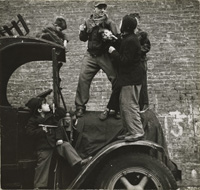
Boys on truck, 1940s
Miriam and Ira D. Wallach Fund
|
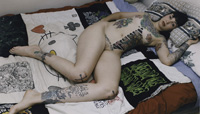
Leslie at home, 1998, printed 1999
Chromogenic print
Miriam and Ira D. Wallach Fund
|
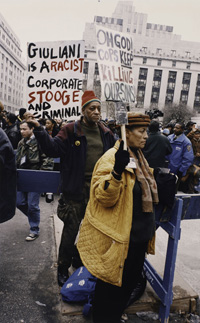
Diallo rally at Foley Square, April 1999
Chromogenic print
Miriam and Ira D. Wallach Fund |
“In [this show] are discoveries of people as they are not represented in … ‘advertised America’— the America whose ideals are: the girl with skin as smooth as a store-window model; … the smile that is pristine and specifically for the occasion; sex that is light without heat, pure surface come-on; childhood that glows with cereal energy goodness; life without individuality, without struggle, and lived before a mirror.”
—Leo Hurwitz, “This Is the Photo League,” Photo Notes, Spring 1949
Jack Delano
(born 1914, Voroshilovka, Russia; died 1997)
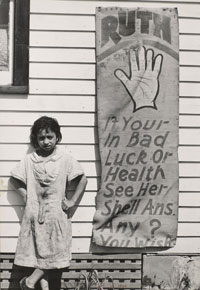
Gypsy girl, 5 miles south of
Salisbury, MD., Farm Security
Administration, 1940
“Most of these pictures are not just records. They achieve that high goal of documentary photography of penetrating into the subject and elevating it to a plane of reality that transcends the moment in which the photograph was made.”
—Robert Disraeli, “The Farm Security Administration,” Photo Notes, May 1940
Godfrey Frankel
(born 1912, Cleveland, Ohio; died 1995)
Pushcart, Orchard St. near Rivington. NYC, 1948
Pharmacy between 42nd & 43rd Sts. on 10th Ave. NYC, 1947
Street light, Canal St. & 3rd Ave. NYC, 1947
Rosalie Gwathmey
(born 1908, Charlotte, North Carolina; died 2001)
Originally trained as a painter at the Pennsylvania Academy of Arts and
the Art Students League of New York, Gwathmey joined the Photo League
in 1942 and contributed to Photo Notes as an editor and writer through 1949. Gwathmey is best known for her significant pictures of labor and housing conditions in her native North Carolina, where she returned annually. Pressure from McCarthy-era politics, the disbanding of the Photo League, and FBI harassment of her husband, the painter Robert Gwathmey, led her to renounce photography after 1951. Gwathmey then destroyed her
negatives and donated her prints to The New York Public Library. After 1955, she enjoyed a successful career as a textile designer.
Pearl Primus, ca. 1947
[Picking berries, Charlotte, North Carolina], 1947–48
[Mother and child, Charlotte, North Carolina], 1947
[Children on a porch, Charlotte, North Carolina], 1943
[A row of shotgun houses, Charlotte, North Carolina], 1946
Tent meeting, 1946
[Group of children, Charlotte, North Carolina], 1946
Paris, France, 1950
Paris, France, from Wedding Series, 1950
May Day, Paris, France, 1950
Paris, Tuileries, 1950
“Our Photo Notes editor, Rosalie Gwathmey, is vacationing in the deep South. She returns there every Summer to keep her son Charles from losing his Southern accent.”
—“Notes About Photographers,” Photo Notes, July 1947
N. Jay Jaffee
(born 1921, Brownsville, Brooklyn; died 1999)
Three girls under the El, ca. 1949. Livonia Avenue, East New York, Brooklyn
Gift of Paula Walter Hackeling
Love for all, New York City, 1973
Gift of N. Jay Jaffee
Helen Levitt
(born 1918, Brooklyn, New York)
New York [Three boys playing in a lot], ca. 1942
Shirley Carter Burden Collection
New York City, 1940s
New York, 1972, printed later
Dye transfer print
The John Whitney Fund
“In the case of Helen Levitt’s documentary work, we have an artist who sees ‘clear to the point of hallucination.’ The general traffic of the universe hardly exists for her except when some scent of lurking danger arouses a sort of panther’s instinct in her, and she stalks her prey to its lair.”
—Joseph Solman, “Helen Levitt,” Photo Notes, Spring 1950
Ann Zane Shanks
(born 1927, Brooklyn, New York)
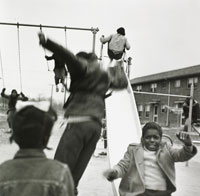
Playground group in Norfolk, Virginia, The Redevelopment Housing Authority of Norfolk, Virginia, 1960s
Miriam and Ira D. Wallach Fund |
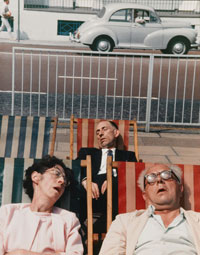
People sleeping in deck chairs. Green Park, London, 1960s
Chromogenic print
Miriam and Ira D. Wallach Fund
|
Lee Sievan
(born Lina Gertrude Culik, 1908, New York, New York; died 1990)
Frank Buck’s exhibit “Catch Them Alive,” New York World’s Fair, 1939
Bequest of Lee Sievan
Weegee with Bolex camera, 1949
Bequest of Lee Sievan
Erika Stone
(born Erika Klopfer, 1924, Frankfurt, Germany)
Couple at artist’s ball, NYC, 1949, printed 1998
Miriam and Ira D. Wallach Fund
John Vachon
(born 1914, St. Paul, Minnesota; died 1975)
Brooklyn-Manhattan Tunnel construction, Standard Oil Company, July 1947
Texhoma, Texas. Wheat storage in the northern panhandle, Farm Security Administration, November 1942
“I would like to see fewer of the habitual formula-made pictures and more experimental work, or at least some new formulas.… [Pictures that fulfill photography’s best function] give an actual sense of being in a place, a mood, a moment which lasted long enough to be recorded.”
—John Vachon, “U.S. Camera Annual 1949,” Photo Notes, Spring 1949
David Vestal
(born 1924, Menlo Park, California)
Monument Valley, UT, 1969, printed 1989
Gift of David Vestal
10th Avenue from bus, New York City, 1990
Gift of David Vestal
Todd Webb
(born 1905, Detroit, Michigan; died 2000)
Storefront churches, NYC, 1945–46:
Lexington Avenue, 1946
Third Avenue, 1946
Third Avenue, December 1945
Lucia Argubright stands in Post Office door of river town, now 4 miles away from the Missouri, now almost a ghost town with less than 100 people. Main Street, Arrow Rock, Missouri, 1955
“Todd Webb sees in terms unlike those many photographers who today command attention as reporters or commentators. Few individual photographs realize the peak of an action that would, in the work of other photographers, be the key to their statement. Webb’s photos stand instead as the quiet observations of a man who finds interest in the usual, the everyday.”
—George Gelberg, “‘I See a City,’ An Exhibition by Todd Webb,” Photo Notes, October 1946
Ida Wyman
(born 1926, Malden, Massachusetts)
The Vera Cruz Cafe, Los Angeles, California, 1950, printed 1979
Miriam and Ira D. Wallach Fund
Sidewalk street clock (New York), 1947, printed 1999
Miriam and Ira D. Wallach Fund
Next Section